
Doughoregan Manor is a plantation house and estate located on Manor Lane west of Ellicott City, Maryland, United States. Established in the early 18th century as the seat of Maryland's prominent Carroll family, it was home to Charles Carroll, a signer of the United States Declaration of Independence, during the late 18th century. A portion of the estate, including the main house, was designated a National Historic Landmark on November 11, 1971. It remains in the Carroll family and is not open to the public.
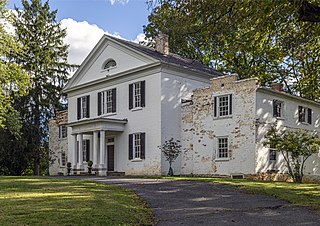
Happy Retreat is a historic property in Charles Town, West Virginia, which was originally owned and developed by Charles Washington, the youngest brother of George Washington and the founder of Charles Town.

Cedar Lawn, also known as Berry Hill and Poplar Hill, is one of several houses built near Charles Town, West Virginia for members of the Washington family. Cedar Lawn was built in 1825 for John Thornton Augustine Washington, George Washington's grand-nephew. The property was originally part of the Harewood estate belonging to Samuel Washington. The property that eventually became Cedar Lawn was left to Samuel's son, Thornton Washington, who built "Berry Hill", named for his wife's family. Berry Hill was destroyed by fire, and John Thornton Augustine built Cedar Lawn when he inherited.

Harewood is one of several houses in the vicinity of Charles Town, West Virginia built for members of the Washington family.

Hawthorne, also known as the Browder Place, is a historic Italianate plantation house and historic district in Prairieville, Alabama, USA. This area of Hale County was included in Marengo County before the creation of Hale in 1867. Hawthorne is included in the Plantation Houses of the Alabama Canebrake and Their Associated Outbuildings Multiple Property Submission. It was added to the National Register of Historic Places on July 7, 1994, due to its architectural significance.

Hilton is a historic home located at The Community College of Baltimore County in Catonsville, Baltimore County, Maryland. It is an early-20th-century Georgian Revival–style mansion created from a stone farmhouse built about 1825, overlooking the Patapsco River valley. The reconstruction was designed by Baltimore architect Edward L. Palmer, Jr. in 1917. The main house is five bays in length, two and a half stories above a high ground floor, with a gambrel roof. The house has a 2+1⁄2-story wing, five bays in length, with a gabled roof, extending from the east end; and a two-story, one-bay west wing. The roof is covered with Vermont slate. The house features a small enclosed porch of the Tuscan order that was probably originally considered a porte cochere.

Woodlands is a historic home located at Perryville, Cecil County, Maryland, United States. It appears to have been constructed in two principal periods: the original 2+1⁄2-story section built between 1810 and 1820 of stuccoed stone and a 1+1⁄2-story rear kitchen wing; and two bays of stuccoed brick, with double parlors on the first story, and a one-story, glazed conservatory constructed between 1840 and 1850. The home features Greek Revival details. Also on the property are a 2-story stone smokehouse and tenant house, a small frame barn and corn house, a square frame privy with pyramidal roof, a carriage house, frame garage, and a large frame bank barn.

Gilfillan Farm is located at the junction of Washington and Orr roads in Upper St. Clair Township, Allegheny County, Pennsylvania, United States. It is a working farm whose current form dates to the mid-19th century.

The Newcomb–Brown Estate is located at the junction of the US 44 highway and Brown Road in Pleasant Valley, New York, United States. It is a brick structure built in the 18th century just before the Revolution and modified slightly by later owners but generally intact. Its basic Georgian style shows some influences of the early Dutch settlers of the region.

The Thomas N. Wheeler Farm is located on Indian Lake Road in the Town of North East, New York, United States, south of the village of Millerton. It is a frame house built at the beginning of the 19th century in the Federal style.
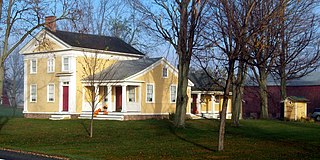
The Benjamin Franklin Gates House is an historic home and farm complex located on Lee Road in Barre, New York, United States. It is centered on a Greek Revival house built in the 1830s using the unusual stacked-plank structural system. The accompanying barn and privy are also included in the listing.

The Isaac Young House is an historic wood frame house on Pinesbridge Road in New Castle, New York, United States. It was built about 1872 in the Second Empire style. Its owner, Isaac Young, was a descendant of early settlers in the area. He chose the Second Empire style, more commonly found in cities and villages than on farms, possibly as a way of demonstrating his affluence. The present structure appears to incorporate parts of a vernacular late 18th-century farmhouse, leaving several anomalies in the current house as a result. The house's position atop a low hill would have, in its time, given it a commanding view of the region, including the Hudson River and New York City's skyline.
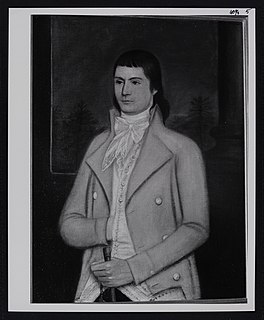
George Steptoe Washington was a Virginia planter and militia officer who died at the age of 37 of tuberculosis.

Dawesfield, also known as Camp Morris, is a historic country house estate located at Ambler in Whitpain Township, Montgomery County, Pennsylvania. The property has 11 contributing buildings, 1 contributing site, and 1 contributing structure. They include the 2+1⁄2-story, stone main dwelling, stone barn, stone tenant house (1845), frame farm manager's house (1884), and eight stone-and-frame outbuildings (1736-1952). The property features landscaped grounds, a stone wall, and terraced lawns.

The Goodwyn-Bailey House at 2295 Old Poplar Rd. in Newnan, Georgia was built in 1835. Also known as Catalpa Plantation, it includes Greek Revival architecture. It was listed on the National Register of Historic Places in 1992. The listing included five contributing buildings and one contributing site on 100 acres (40 ha).

Mount Joy is a historic slave plantation in Ellicott City, Howard County, Maryland, which has a current address of 5000 Executive Park Drive.

Kimball Castle is the former summer estate of railroad magnate Benjamin Ames Kimball. It is located on a hill overlooking Lake Winnipesaukee in the town of Gilford, New Hampshire, United States. Although portions of the Kimball's original 300-acre (120 ha) estate have been subdivided, much of it remains conservation land managed by the town. The 20.1-acre (8.1 ha) subdivided portion on which the 2+1⁄2-story medieval-style castle stands is privately owned and no longer part of the Charlotte Kimball trust.

The Darling Estate Historic Estate encompasses an historic country estate of more than 2,000 acres (810 ha) on Darling Hill Road, straddling the town line between Burke and Lyndon, Vermont, USA. Built in the early 1900s for Elmer Darling, a locally-born New York hotelier, it was one of Vermont's largest such estates, featuring Burklyn Hall, one of its most opulent Colonial Revival houses, as well as numerous 19th-century farm properties. It was listed on the National Register of Historic Places in 2011.
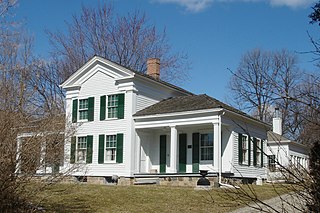
The Royal Aldrich House is a single-family house located at 31110 West 11 Mile Road in Farmington Hills, Michigan. It was listed on the National Register of Historic Places in 1994. It is one of a few remaining Greek Revival style houses in southeast Michigan still located on the site where built.
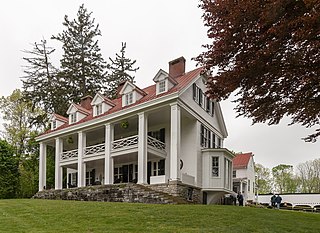
Wild Goose Farm is a 173-acre (70 ha) farm complex near Shepherdstown, West Virginia, established in the early 19th century. The farm includes a large, irregularly-arranged main house, a Pennsylvania-style bank barn, a tenant house, and outbuildings including a spring house, smoke house, ice house, corn crib, water tower and a decorative pavilion.






















